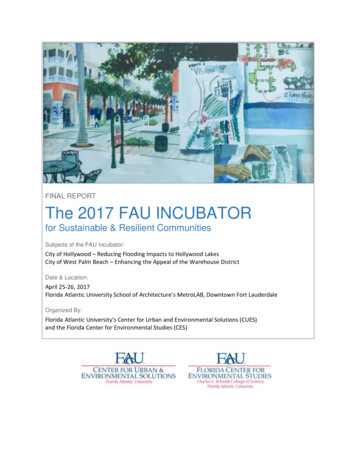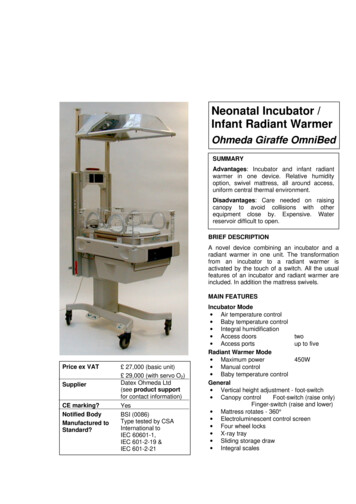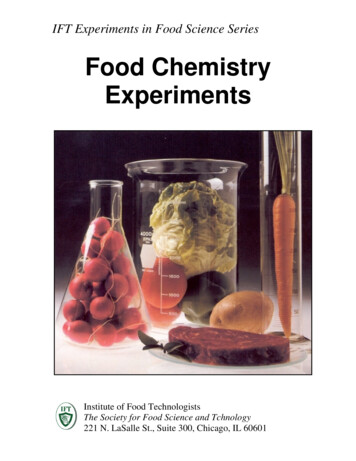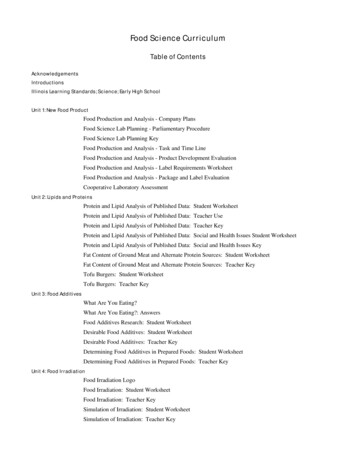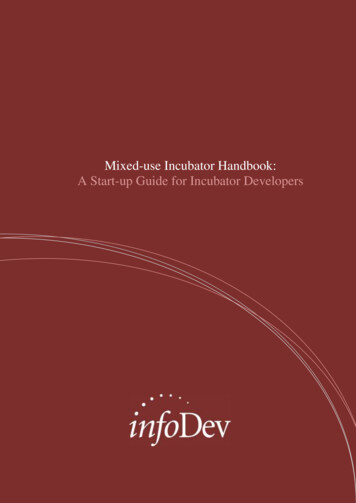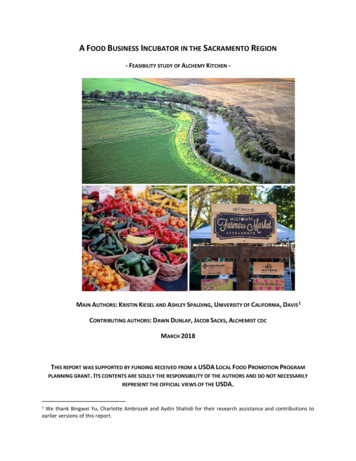
Transcription
A FOOD BUSINESS INCUBATOR IN THE SACRAMENTO REGION- FEASIBILITY STUDY OF ALCHEMY KITCHEN -MAIN AUTHORS: KRISTIN KIESEL AND ASHLEY SPALDING, UNIVERSITY OF CALIFORNIA, DAVIS 1CONTRIBUTING AUTHORS: DAWN DUNLAP, JACOB SACKS, ALCHEMIST CDCMARCH 2018THIS REPORT WAS SUPPORTED BY FUNDING RECEIVED FROM A USDA LOCAL FOOD PROMOTION PROGRAMPLANNING GRANT. ITS CONTENTS ARE SOLELY THE RESPONSIBILITY OF THE AUTHORS AND DO NOT NECESSARILYREPRESENT THE OFFICIAL VIEWS OF THE USDA.We thank Bingwei Yu, Charlotte Ambrozek and Aydin Shahidi for their research assistance and contributions toearlier versions of this report.1
TABLE OF CONTENTSExecutive Summary.4Background .5A Project Definition of ‘Local’ .6The Local Food Economy in the Sacramento Region .8Existing Studies: Supply of Locally Produced Foods .10Food Hubs and Values-based Supply Chains . 14Potential Economic Impact on the Sacramento Region. 15Existing Studies: Demand and willingness to pay for local food .18Additionally Collected Project Data .22Interest and Need Assessment of Local Food Businesses .22Surveys: Farmers, Food truck operators, Cottage Food Operators . 22Interviews: Farmers, Food trucks, Cottage Food Operators . 25Potential Demand for Locally Produced Value-Added Products .31Willingness To Pay: Preserves.34Willingness To Pay: Baked Goods .35Sale Price and Wholesale Cost .37Existing Incubator Models, Possible Local Collaborations, and Lessons Already Learned . 40Existing Incubator Models .40US Kitchen Incubator Industry Report . 41La Cocina . 45El Pájaro. 47L.A. Kitchen. 48Hot Bread Kitchen/HBK Incubates . 49Related Local Concepts and Lessons Already Learned. 52Alchemist CDC and Currently Considered Potential Collaborators.57Alchemist CDC . 58Existing Commercial Kitchens . 59The Food Factory . 62Currently Considered Potential Community Partners . 62Overall Benefit-Cost Evaluations and Feasibility Assessment .652
Potential Benefits .66Cost Considerations .68Recommendations .70Works Cited .74Appendix A: Survey Contact Lists .78Appendix B: Detailed Survey Results .863
EXECUTIVE SUMMARYThis feasibility study discusses the potential for success in the development and implementationof a food business incubator (referred to as incubator or food incubator for the remainder of thereport) in the Sacramento region. Funding for this study comes from a USDA Local FoodPromotion Program grant and is intended to inform Alchemist Community DevelopmentCorporation’s (Alchemist CDC) planning efforts in developing a local commercial kitchen andincubator business model (Alchemy Kitchen).The incubator addresses food insecurity within low-income neighborhoods and createsopportunities for economic growth, particularly within the Sacramento Promise Zone. AlchemyKitchen aims to provide a shared commercial kitchen, business development classes andmentoring to assist small food business entrepreneurs and build on the comparative advantagesof the region. In establishing a network and supporting potential synergies in both supply chainmanagement and distribution, the incubator aims at increasing market access andcompetitiveness of small food businesses and stimulating demand for value-added locallyproduced foods. At the same time, it wants to create new job opportunities for low-incomeresidents, new revenue streams for local farms, and increase community access to affordableand locally produced healthy foods. This report addresses the following objectives in determiningchallenges and opportunities for the proposed local food incubator:1) Review the related research literature and successful food business incubator concepts.2) Determine needs and barriers to success of potential users.3) Assess potential cost savings due to synergies and economies of scale in supply chainmanagement. In particular, investigate the potential to reduce food waste.4) Explore potential partnerships to support direct distribution channels for small producerswithin the community (e.g. through Farmers’ markets, Food Co-ops, and CommunitySupported Agriculture).5) Estimate the potential demand and willingness to pay for locally sourced and producedfood products within the community.6) Identify potential benefits to the community in terms of job creation, increased revenueand value generation, and access to healthy foods from a local food incubator.7) Discuss cost considerations including possible funding sources and pricing models.The above supply and demand side considerations inform the recommendations in this reportfor implementing the proposed Alchemy Kitchen incubator project. This report also informs grantwriters, local non-profits, food businesses, and government stakeholders about the generalpotential for creating a successful and sustainable food business incubator in the region.4
In conclusion, the implementation of a food incubator business within the Sacramento Regionhas great potential. A kitchen incubator could improve the existing infrastructure and strengthenvalue-based supply chains for local foods, by serving as an intermediary and providing growthopportunities and market access to small local businesses or aspiring entrepreneurs. A kitchenincubator can further provide consumption gains for the entire community, as well as forunderserved populations within, productivity gains and increases in asset value for localproducers recruited and trained from these communities. Consumption gains can come fromtaking advantage of synergies and economies of scale that make products more competitive, andfrom an increased availability and access to foods, especially if the incubator also serves as aretail location and operates as a social enterprise business. Establishing self-sufficient local foodbusinesses that empower entrepreneur-minded minorities with access to limited resources canstrengthen their unique marketable skills, increase the revenue streams to local businesses andgenerate greater income for local employers overall. In short, a kitchen incubator couldcontribute to a more equitable local food system and economic growth in the greaterSacramento region.However, implementing and sustainably running the proposed kitchen incubator will ultimatelydepend on Alchemist CDC’s ability to successfully collaborate with community partners, andgovernmental and research institutions, to take advantage of and build on their varying expertise.The most pressing challenge is to ensure the financial feasibility and long-term profitability of thisproposal. Alchemist CDC needs to identify and engage with interested investors, and establishpartnerships with financial institutions to raise the significant start-up funds needed. Learningfrom existing successful incubators and related failed attempts, Alchemist CDC needs tocreatively think about pursuing a business model that creates a sizable revenue stream whilecontinuing to secure public and private funding for the first 3 to 5 years. Even after this initialimplementation phase, it is unlikely that this project will be fully self-sustaining and able to coverall its operating costs.BACKGROUNDAs “America’s Farm-to-Fork Capital”, the Sacramento region has abundant and diverse food andagriculture crops. While people often think of agriculture as a predominantly rural industry, theSacramento Area Council of Government (SACOG) found that most of the region’s specialty cropjobs are actually located in urban areas. The Food and Agriculture Sector as a whole provides 32thousand on- and off-farm jobs and contributes 6.8 billion dollars to the regional economy(SACOG, 2016).5
At the same time, Sacramento is home to a federally designated Promise Zone, encompassingone of the economically hardest‐hitSpecialty Crops:areas in the nation. In the SacramentoPromise Zone, unemployment is Specialty crops are defined as “fruits andstagnant at 18 percent and over 34vegetables, tree nuts, dried fruits andpercent of the residents live in poverty.horticulture and nursery crops, includingfloriculture.” (USDA, Agricultural MarketingThis area also suffers from limitedServices, 2017)access to affordable and healthy food “From rows of fresh vegetables to blooming(HUD, 2015).orchards and rolling hills of wine grapes, thisAlchemist CDC seeks to address thesesector is the heart of specialty cropagriculture”. (SACOG, 2016).disparities by creating AlchemyKitchen—a food business incubator.Alchemy Kitchen will support local food businesses, foster jobs and increased economic activityfor low-income food entrepreneurs and local farmers. Supported by one of 19 grants awarded in2016 by the USDA under the Local Food Promotion Program, Alchemist CDC and one of itspartners on this grant—the University of California, Davis (UC Davis)—committed to thecompletion of this feasibility study. The study was prepared by a team of undergraduate andgraduate research assistants, led by Dr. Kristin Kiesel, faculty member of the Department ofAgricultural and Resource Economics at UC Davis.As an additional grant component, Alchemist CDC is developing a business plan in collaborationwith the other main partner on this grant (Capsity, Inc.). The project has received endorsementfrom community leaders, including Congresswoman Doris Matsui, Assemblymember KevinMcCarty, State Senator Richard Pan, and Sacramento City Council members Jay Schenirer andSteve Hansen. Diverse community organizations, among them SACOG, Valley Vision, CertifiedFarmers’ Markets of Sacramento, Roots Creative Kitchen, International Rescue CommitteeSacramento-New Roots program, Sacramento Food Policy Council, Sacramento ChineseCommunity Service Center, Sacramento Food Bank and Family Services, Slow Food Sacramento,WayUp Sacramento, Wellspring Women’s Center, and Sacramento Housing and RedevelopmentAgency also indicated their willingness to support this project and will be considered as possiblecollaborators moving forward.A PROJECT DEFINITION OF ‘LOCAL’The growth of the local food movement in the United States is rooted in the environmental,community food security, and slow food movements (Guptill and Wilkins, 2002). In California, itsorigin is also in the trends set by Chez Panisse, and the interests of foodservice professionals atschools and hospitals in purchasing local food. Interest in local foods is further sustained by6
increasing consumer concern about the sources and ways food is processed (Martinez et al 2010).Although federal and state standardsValue-added food products:have been developed for other valueadded food designations like Organic, Value-added food products are defined as “aHumane, and Fair Trade, etc. there ischange in the physical state or form of theno comprehensive definition of localproduct (such as milling wheat into flour orfood.making strawberries into jam).” They can also describe the “production of aBoth local and regional food systemsproduct in a manner that enhances its value,are referred to as place-specificas demonstrated through a business plan(such as organic production).” (USDA, Ruralclusters of agricultural producers,Business Development, 2017)along with consumers and institutionsengaged in producing, processing,distributing, and selling foods in existing studies. Since neither term is well defined, thedistinction between local and regional food systems is unclear in the existing literature and theseterms are often used interchangeably.The 2008 Farm Act defines local foods as those produced in “the locality or region in which thefinal product is marketed, so that the total distance that the product is transported is less than400 miles from the origin of the product; or the State in which the product is produced”(Consolidated Farm and Rural Development Act of 2008). Census data availability framed thedefinition of locally marketed foods in the Sacramento region as those produced within the Yolo,Sacramento, Placer, and El Dorado county region that comprises the Sacramento MetropolitanArea in recent research that quantifies the economic impact of local farming (Hardesty, et al.,2016). Local food retailers often develop their own definitions of local to promote these productsin their stores. The Davis Food Co-op, for instance, defines local as products grown or madewithin 100 miles of the Co-op 2.To some consumers, local food is primarily defined by local ownership or by direct-toconsumer/direct-to-retailer sales. Others may define “localness” by natural, organic, and otherspecialty characteristics of the product (Low et al, 2015). One advantage of locally-growndesignations, in that context, is that they provide profitable differentiation strategies without theupfront investment of organically-grown and similar certifications (James et al, 2009).Informed by these varying approaches, the Alchemy Kitchen project will need to define whatconstitutes local food. This definition should:2See t.7
1) complement the purpose of the project;2) be understood and valued by the target consumer population; and3) be observable and enforceable.Since Alchemy Kitchen will be both sourcing and processing food products, it is possible to choosetwo definitions, one for “locally grown” and one for “locally produced”. For “locally grown,” thefollowing definition is suggested:Agricultural inputs whose point of harvest or origin is within the Census Bureau’s fourcounty Sacramento Metropolitan Area, consisting of El Dorado, Placer, Sacramento andYolo counties.It will allow the project to incorporate estimates of the economic impact of the proposedincubator kitchen to the estimated economic impact of local food producers in the Sacramentoregion and utilize census data in the future. A second definition for “locally produced” shouldbecome an essential part of the incubator’s branding strategy and ultimately the incubator’s ownlabel. Both branding and marketing opportunities in this regard will be discussed in detail in thebusiness plan for this project.THE LOCAL FOOD ECONOMY IN THE SACRAMENTO REGIONCalifornia is 1 of just 5 Mediterranean climates in the world that not only provides uniquerecreational opportunities, and diversity in wildlife, but also has a competitive advantage as anagricultural producer, as pointed out in SACOGs Rural-Urban Connection Strategy (SACOG, 2015).The Sacramento region is already a leader in a shift to farm-to-fork consumption. Their proximityto two distinct major metropolitan areas - Sacramento and the San Francisco Bay Area, uniquelypositions the region’s growers. It allows them to capitalize on the rapidly expanding demand forlocally grown food and access growing consumer markets.In turn, situated close to the agricultural abundance of the Central Valley, the Sacramento regionhas supply-chain advantages for specialty crops and in producing value-added products fromthese crops. The region is already growing a variety of high-value crops such as almonds, walnuts,plums, peaches, pears, grapes, kiwifruit, tomatoes and olives. In Sacramento, Yolo, Placer, and ElDorado counties in 2007, 733 farms made direct sales to consumers (representing 14 percent offarms in the region). 23.8 acres of vegetables were harvested for fresh markets per 1,000population, placing this region in the top range for the United States (USDA, Economic ResearchService, 2017). Yet, only two percent of the food consumed in the region comes from localsources. And even if products are locally sourced, much of the value of Sacramento’s locallygrown foods is added outside of the region, as commodities are shipped out and value-addedproducts return to our retail stores. It therefore seems that regional farmers are not fully takingadvantage of market opportunities and would benefit from expanded regional agricultural8
infrastructure and direct market opportunities to help them sell the crops they grow locally.Farmers are only one element of a much larger food system. Supportive industries (such asdistribution, storage, and processing facilities) further refine, enhance, and move food productsto consumers; increasing marketing opportunities as an essential part of a sustainable local foodsystem (SACOG, 2015).One way in which local food production has been increasing is through improved market accessfor small home-based food businesses. Recent California legislation—the Cottage Food Bill thatbecame effective in January of 2013—resulted in over 200 home-based food businesses beingregistered in Sacramento. While interest in these new opportunities continues to grow, thisregulation also limits how much a home-based entrepreneur can expand their business.Operations are subject to a cap of 50,000 in gross sales annually. In addition, few resources areavailable to help interested entrepreneurs create viable businesses that potentially scale up fromhome production. For instance, access to commercial kitchens and related training for businessdevelopment remains limited in this region.The demand for locally grown and produced foods by more affluent and educated consumers ingeneral is already established in the literature.3 A study by the Sacramento County Planning andCommunity Development Department contrasts these findings with their conclusions regardingaccess to healthy foods in communities with the highest rates of poverty (Planning andCommunity Development Department, 2010). A number of initiatives already aim at improvingaccess and increasing consumption of locally grown produce in the Sacramento region. Thesecommunity-focused efforts include Alchemist CDC’s CalFresh at Farmers’ Markets: ConnectingFamilies to Farmers project. Furthermore, as a result of collective efforts in the region led byValley Vision and SACOG, two plans were developed: The Next Economy: Workforce DevelopmentRecommendations for the Agriculture and the Food Industry Cluster (March 2014); andSacramento Region Food System Action Plan (Valley Vision, 2015). Both of these plans emphasizethe need to support regional farmers and the demand for local food production spaces.Ultimately, these efforts can address limited access to healthy foods while also providingopportunities for job creation and economic viability.The Food and Agriculture Sector as a whole currently provides 32,000 jobs and 6.8 billion dollarsin revenue, creating ripple effects throughout the region’s economy at large. The creation ofadditional jobs and revenues can then boost the economy even further. This impact can bequantified into estimated average economic multipliers. SACOG aims at quantifying thiseconomic impact and estimates an employment multiplier of 1.82 for jobs related to specialtycrops, as well as a value-added multiplier of 1.90. In other words, each of these specialty cropThe section (Existing Studies: Demand and willingness to pay for local foods) summarizes the existing literature inthat regard.93
jobs generates another 0.82 jobs in other areas of the regional economy. In addition, each dollarthese specialty crop businesses contribute to gross regional product generates an additional 0.90 across other regional industries (SACOG, 2016).These potential economic benefits and multiplier effects might even be larger in certaingeographical areas. In 2015, an area in Sacramento that runs through South Sacramento, OakPark, downtown and up through NorthFederal Promise Zone Initiative:Highlands was federally designated as aPromise Zone in the second round of this Promise Zones are high povertyinitiative. A Promise Zone is an area with acommunities with great potential forhigh rate of poverty and yet, due to theeconomic growth.community organizations, government Goals of the initiative: (1) create jobs, (2)institutions, healthcare providers, andincrease economic activity, (3) improveeducational opportunities, (4) improveschools, has a strong potential and capacityhealth and wellness, and (5) facilitateto address these issues. Through the Promiseneighborhood revitalization. (HUD, 2017)Zone Initiative, the Federal government willwork strategically with local leaders to boosteconomic activity and job growth, improve educational opportunities, reduce crime and leverageprivate investment to improve the quality of life in these vulnerable areas. (U.S. Department ofHousing and Human Development, 2017)The remainder of this section provides an overview of existing research regarding supply anddemand determinants of local foods, with specific consideration given to regional specificaspects.EXISTING STUDIES: SUPPLY OF LOCALLY PRODUCED FOODSThe US Food system transformed from small, pre-industrial farming systems to industrializedagriculture over the 20th century (Hardesty, et al., 2016). Local food markets account only for asmall share of total U.S. agricultural sales. In 2012, 7.8 percent of U.S. farms sold food throughlocal food marketing channels, including direct to-consumer (DTC) marketing channels (e.g.,farmers’ markets, roadside stands, u-pick) and intermediated marketing channels (e.g., direct torestaurants, institutions, grocery stores, food hubs) (USDA, 2015). Participation of producers inlocal markets is growing significantly, however. Relying on the 2012 Census of Agriculture, theAgricultural Resource and Management Survey (ARMS) from 2007-2011, the 2011-12 USDA Farmto School Census and 2006 Nielsen Homescan data, the Economic Research Service (ERS)10
summarizes the following trends in local and regional food systems in their report to the UnitedStates Congress: 4In 2012, 163,675 farms (7.8 percent of U.S. farms) were selling foods locally, utilizingeither direct-to-consumer (DTC) or intermediated marketing channels. Of these farms, 70percent used DTC marketing channels exclusively, which include farmers’ markets andcommunity supported agriculture (CSA)Food hubs:arrangements. The other 30 percent used acombination of DTC and intermediated A food hub is defined as “achannels or solely intermediated channels.centrally located facility with a The number of farms with DTC salesbusiness management structureincreased by 17 percent and sales increasedfacilitating aggregation, storage,by 32 percent between 2002 and 2007.processing, distribution, and/orHowever, between 2007 and 2012 themarketing of locally/regionallynumber of farms with DTC sales increasedproduced food products.” (USDA,5.5 percent, with no change in DTC sales.2010) Local food sales totaled an estimated 6.1billion in 2012. Farms with gross cash income below 75,000 accounted for 85 percent of local food farmsin 2012. In contrast, these farms are estimated to account for only 13 percent of localfood sales. Local food farms with gross cash-farm income above 350,000 accounted for67 percent of sales. Farms selling local food through DTC marketing channels were more likely to remain inbusiness over 2007-12 than farms not using DTC marketing channels, despiteexperiencing smaller increases in sales than other farms.Similar trends are reported in other studies. More specifically, producers in direct marketing tendto be smaller, more labor-intensive and source more of their inputs locally. It is worth pointingout that although volume of direct sales has been increasing, revenues from direct marketing aredeclining in real dollar terms (Hardesty, et al., 2016). Farmers markets continue to offer animportant marketing channel, but other intermediaries such as food hubs are becoming moreabundant and could play an important role in securing access to and increasing consumerdemand for local foods. Please note that growth in non-direct sales and value of intermediated sales of local food is not included in themeasures reported here and might account for the slowing trend observed.114
Figure 1: Increase in Local & Regional Marketing ChannelsThe interests of foodservice professionals, reinforced by the federally designated Farm to SchoolProgram objectives that range from nutrition education to serving locally sourced food in schoolmeals to meet mandated guidelines or voluntary commitments at the federal, state and locallevel, might have been important determinants of the observed growth. According to the USDAFarm to School Census, 4,322 school districts have farm to school programs, a 430-percentincrease since 2006 (USDA ERS, 2015).In addition, the 2012 Census of Agriculture asked farmers to report if they sold any food forhuman consumption through outlets that in turn sell directly to consumers (includingrestaurants, grocery stores, schools, hospitals, or other businesses) drastically increasing thevalue of local food sales. While these numbers are not fully analyzed yet, most of the growth insales might have occurred in this channel, and prices at DTC outlets are generally lower, onaverage, than prices at retail stores in all seasons (USDA, 2015).Small farms’ revenue will only grow, however, if they continue to access those markets in anentrepreneurship-friendly environment that provides assistance to develop and grow their ownbusinesses, or supports local businesses that directly source from these farmers. Integratingthese farmers, local producers and intermediaries can sustain the continued growth of local foodsystems and result in significant economic multiplier effects by securing additional income andcreating new job opportunities in local communities. However, it is precisely the lack ofinfrastructure (e.g. limited production facilities, storage units and distribution channels) that ismost often cited as a significant barrier to starting and/or growing a business for local smallfarmers and food entrepreneurs in this context (Shipman, 2009; Vogt & Kaiser, 2008; Kirby,Jackson, & Perrett, 2007; Chefs Collaborative, 2008).12
Local foods have also been the subject of federal, state, and local government policy in recentyears. This might be due to the fact that theyCODEX Alimentarius:are linked to USDA priorities including: The CODEX Alimentarius (latin forenhancing the rural economy, the“Food code”) is a collection of scienceenvironment, food access and nutrition,based international food safety,informingconsumerdemand,andproduction and labeling informationstrengthening agricultural producers andstandards designed to prevent ofmarkets. Federal policies related to local andeconomic fraud and consumerregional food systems were greatly expandeddeception.by the Food, Conservation, and Energy Act of The FDA participation ensuresconsistency with U.S. regulations and2008, and are further expanded in thelaws. (FDA, 2016)Agricultural Act of 2014, which strengthenedsupport for intermediated marketingchannels. The 2011 Food Safety Modernization Act (FSMA) also directs the FDA to implement thel
a food business incubator in the sacramento region - f. easibility study of . a. lchemy . k. itchen -m. ain authors: kristin kiesel and ashley spalding, university of california, davis. 1. contributing authors: dawn dunlap, jacob sacks, alchemist cdc. march 2018 . this report was supported by funding received from a usda local food promotion program planning grant.its contents are solely the .
